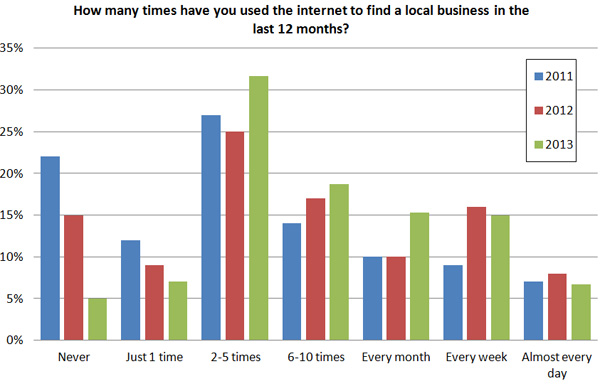85% of consumers use the Internet to find a local business.If you don’t have a presence online, your potential customers may not find you. Whether they are new in town or have lived here all their lives, more and more people are using the Internet to research their purchase decisions. Both individual consumers and business-to-business clients turn to the Internet to learn about your company and service before they ever consider making a phone call.
According to a 2012 by Search Engine Land
 |
| Graph by Myles Anderson, from the Local Consumer Review Survey, June 2013 |
What will those prospects find when they look online for your service?
One: Your website
Do you have a website that clearly defines your services? Does that website differentiate you from your competition? Does it direct people to a specific call to action so you can establish contacts? Can your prospects easily find your website when searching for it on Google, Bing or other search engines? Just having a website isn’t good enough – in fact, a poorly done website can hurt more than help.
Two: Social Media
 Twitter, Facebook, YouTube, LinkedIn and blogs all have a purpose for your business. In many ways, they have a stronger influence on local business than on a national level. Online reviews and service recommendations are the new “word-of-mouth” standard and it’s important that you have some control over how your business is portrayed.
Twitter, Facebook, YouTube, LinkedIn and blogs all have a purpose for your business. In many ways, they have a stronger influence on local business than on a national level. Online reviews and service recommendations are the new “word-of-mouth” standard and it’s important that you have some control over how your business is portrayed. Tip: Create a Google Places page with accurate information. A Google Map result will often appear above other search results for your prospects. And the map makes it even easier for people to find you.
Check out our blog series on Social Media & Your Business.
Three: A bridge between your online and offline locations
Once you have an active online presence it’s time to make sure you tie it all together. Do your business cards refer to your website? Does your Facebook page include your business location? Are you consistently listing your business hours in all places? Your physical office and your online resources should not exist separately from each other. They should help people gather accurate information and build connections.
Tip: Audit all communication pieces. Gather all printed pieces (brochures, business cards, letterhead, etc.) and pull up each of your online presences on the browser. Make sure all key business information is accurate and consistent across all your communication vehicles.
Need help with your digital marketing strategy? Talk to usTip: Audit all communication pieces. Gather all printed pieces (brochures, business cards, letterhead, etc.) and pull up each of your online presences on the browser. Make sure all key business information is accurate and consistent across all your communication vehicles.
